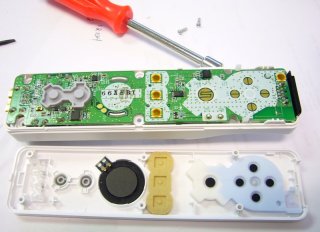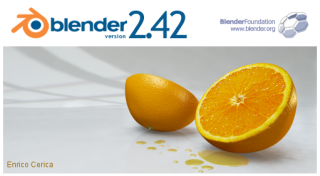|  |
|
tech: Camspace: Markerless Tracking that's Free (as-in-beer)
|
|

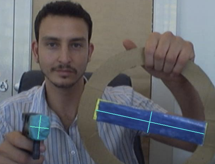 A small team in Tel Aviv, Israel has been working on what they describe as a paradigm shift in gaming: rather than using an input device like a WiiMote or mouse+keyboard (almost) any object in the room can be trained to be tracked by a standard webcam and their software. A small team in Tel Aviv, Israel has been working on what they describe as a paradigm shift in gaming: rather than using an input device like a WiiMote or mouse+keyboard (almost) any object in the room can be trained to be tracked by a standard webcam and their software.
Check out their impressive demo here. They just pick up a brightly coloured object, train and then track.
To be fair, this technology has been around for quite a while in computer vision, popularised most of all by Intel's OpenCV library which allows for defining and tracking many different Regions Of Interest (to unpack a geeky acronym).
Read on for more about this great technology (and why it won't displace the WiiMote any time soon)..
|
|
archive: ARToolkit and Blender Game Engine
|
|

With a little Python to interface ARToolkit with the Python API of the Blender Game Engine, Slovakian Ashid is creating a plugin allowing Blender to be an editor and engine for Augmented Reality content. Check it out here. It's not realtime yet: he's working with pre-recorded video for the time being. Nonetheless, the future is bright for this tool it seems.
Fine work Ashid! Cheers to Olme for letting us know about this development. Archived in the Tools section for posterity.
|

Friedrich Kirschner has made a great little D.I.Y 3D-Scanner, software and all.
The ingredients:
- 1 Webcam
- 1 Tupperware Bowl
- 3 cups of Milk
- 1 custom LEGO rig
Nice work fiezi and thanks to Brandano for putting me onto it. Watch the Milk-Scanner in action here.
|
|
archive: Rapid prototyping for the Wiimote using Blender
|
|

 While here at Georgia Tech I'm giving a class on the development of 'expressive games', and for the purpose I chose Nintendo Wiimotes as the control context for class designs. The final projects will be produced in Blender, using the Blender game engine. While here at Georgia Tech I'm giving a class on the development of 'expressive games', and for the purpose I chose Nintendo Wiimotes as the control context for class designs. The final projects will be produced in Blender, using the Blender game engine.
To get them started I've developed a couple of basic interfaces between the Wiimote and Blender. They're intended to be used as skeleton files for building up rich Wiimote aware content in Blender quickly.
Read on for more including code and Blender files:
|

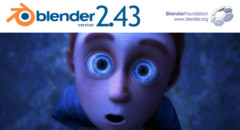 This is an impressive release for the already impressive 3D modeling, animation and game creation suite, Blender. This is an impressive release for the already impressive 3D modeling, animation and game creation suite, Blender.
At around 10Mb Blender ships with alot of goodness, and all open source. The fairly epic release notes list additions such as Sculpt modeling, image painting, multi-resolution meshes, multiple UV's, Shader support, Fluid dynamics, improved Python API and hinges and constraints in the Bullet physics engine.
Get it here.
(Perhaps worth mentioning I've nearly completed a demo file showing how you can use Wiimotes (Wii controllers) to drive content in the Blender game engine. More on that soon.)
|
|
tech: First Wii-Mote on PC homebrew surfaces
|
|

Recently I wrote about the console hacking talk at the 23C3 in Berlin. The article recounts Felix's fine suggestion that a Wii-Mote and a PC is all you need to explore developing interactive content along the lines of what you see on the console itself.
With typically good timing, Chris O'Shea writes with a fine link exposing the internals of the Wii-Mote, just to demystify the whole interface further.
Aside from the obvious cultural kudos granted by using a Wii-Mote in your art project, it's worth mentioning that the Wii-mote isn't new technology in itself. What it is however is perhaps the first economically sane intersection of several technologies many performance artists/musicians have been using for a while: Accelerometers and a couple of IR sensors used for positioning. The fact it's a bluetooth device also makes it far more accessible to those of us that don't want to D.I.Y an interface between the sensors and a machine, especially now that several tookits are now surfacing that do alot of the technical groundwork.
That said, if you're prone to a healthy bout of the N.I.H syndrome, and want to build your own super Wii-Mote, you could avoid bluetooth altogether and go wireless. That'll give you far more range than a bluetooth device ever will. Good luck with capturing positional info with IR over that range though; albeit not necessary if gesture is your primary control data..
Chris also points us to a super YouTube clip of a WiiPC interface aptly called WiiSticks that really exploits the accelerometers to a maximum as a function of play.
While we're at it, here's another YT clip showing how the Wii can be used to navigate a Linux desktop machine. Note the candles in the foreground which he seems to be using as InfraRed emitters so he can get that positional data. The API they're using for this demo is here.
Cheers Chris!
|
|
G3DRuby. Write OpenGL Apps in Ruby
|
|

G3DRuby is an extension for the high-level G3D library, allowing you to author 3D applications directly in Ruby. The rationale for doing this? Ruby is far more accessible than C++ (a good first language) and does away with the need to recompile between changes.
G3DRuby is a little less low-level than PythonOpenGL, which gives you immediate access to the full scope of OpenGL itself in the dynamic interpreted language Python, but it probably saner if you just want to get something up and running fast.
Currently G3DRuby runs on Linux (tested on Ubuntu 6.10) and Win32.
|
|
archive: Make Second Life Models in Blender
|
|

Yet again Blender's powerful Python API bears fruit.
Prim.Blender is script to get your Blender meshes into Second Life. While I haven't tried it myself, this apparently makes a great alternative to Google's Sketchup, whose primitives are well... a bit too primitive in game. Unlike Blender and Second Life, Sketchup also doesn't run on a Linux machine.
Apparently the Prim importer on the SL side is currently disfunctional but keep a tab open on this project anyway, while they sort it out.
|
|
tech: Royalty-free tileable texture pack released
|
|

Making textures loop along a mesh without discernable points of repitition can be a painful experience. The kind folk at Spiral Graphics have released a pack of 150 quality seamless tiling textures for free download and distribution, bless their pixelated souls.
Looking at a few of them it appears they're well suited for converting to bump-maps too. Grab them here.
|
|
tech: Game code available
|
|
 Anonymous writes "Thought I'd let you all know I've pulled out of game dev (I have been doing a research masters in comp-sci on real-time audio synthesis for computer games and have been acting head of a games reseach lab this last semester). Getting involved in commercial game dev means getting ripped off and burnt along with making truly crap games (oh what an industry!) and I find teaching it to be unethical in Australia at this point in time, primarily due to industry size and attitudes.
Anonymous writes "Thought I'd let you all know I've pulled out of game dev (I have been doing a research masters in comp-sci on real-time audio synthesis for computer games and have been acting head of a games reseach lab this last semester). Getting involved in commercial game dev means getting ripped off and burnt along with making truly crap games (oh what an industry!) and I find teaching it to be unethical in Australia at this point in time, primarily due to industry size and attitudes.
I've released some code from my studies recently, anyone working on multithreaded real-time software or game engine development may find it useful.
http://ldk.sourceforge.net
Lorien Dunn
acmipark Sound Programmer"
|
|
archive: Free Interactive 'Visual Novel' engine released
|
|

Here's one for you hardened narratologists wanting to push theory into practice.
BladeEngine is an interactive novel authoring and presentation engine from CuriousFactory and Buredo. It's freely downloadable (though not open source) for the Windows platform here. As a Linux user I haven't been able to try it. If you do and feel like writing a little review of your experiences, drop us a line and we'll post it.
Says the site:
What is Visual Novel?
Most Visual Novels have multiple storylines and many endings; the gameplay mechanic in these cases typically consists of intermittent multiple-choice decision points, where the player selects a direction in which to take the game. This style of gameplay has been compared to the Choose Your Own Adventure novels. Most, however, strive for a higher level of plot and character depth than the aforementioned series of interactive children's books. These can be more closely compared to story-driven interactive fiction.
Content and Genre of Visual Novel
In the West, there is a stereotype of: "Visual Novel = Dating Sim Game = Hentai", but that is wrong. Visual Novels CAN be Dating Sim games, Ren'ai games, Bishoujo games but also can be Sci-Fi, Fantasy, Adventure and Horror Fiction games, or anything that the user's creativity comes up with.
|

As the title suggests, a new version of the powerful open-source modeling, animation and game development suite Blender has been released.
For game developers, this spells good news. The physics engine, 'Bullet' is now the default physics context, there are also several speed and stability increases to the engine itself. For modelers and animators Blender continues it's march into direct competition with the expensive, disk-munching and proprietary 3DSMax and Maya.
A full list of the new features is available here.
|
|
tech: Ubuntu-6.06: OpenSource Game-dev platform of choice.
|
|

Ubuntu, the free OS used by millions of people the world over reached it's 6.06 milestone today. It's a stunner of a release and now has a try-before-you-buy 'LiveCD'; just boot up without installing anything and if you like what you see, click the 'Install' icon. Download it here (try the torrents for a snappy download).
Ubuntu comes with the Selectparks Special Nod for those interested in a solid, easy to use, low-maintenance platform for open-source game development. Like many Linux distributions Ubuntu is based on the all incumbent Debian, reknowned for it's excellent software management system and stability. There are 17000+ software free-software packages available in Ubuntu and are downloaded from a secure and geographically local repository on demand. There's no hunting around websites to find and install software and all software on your machine can be upgraded simultaneously, at any time, with just a few clicks.
This makes it fantastic as a stable development machine (and also as a desktop). If you want to install Python OpenGL bindings, SDL joystick support along with the sourcecode for an RPG you find in the package manager, they are just a click away..
|
|
tech: Smart Retina And MossaLibra
|
|
 Anonymous writes "
Anonymous writes " SmartRetina is a lightfast gesture-tracking platform written in Macromedia Flash 8, utilizing its flash.geom. package, flash.display package, Video class, Camera class and their motion-tracking capabilities. SmartRetina is used to develop Retina Based Interfaces – Interfaces which: 1. Purely use visual interaction and can fully function without using text or audio.
2. Strictly serve as translators between human gestures and machine functions.
3. Can be self-explanatory at their introductory level, since representations of the supported gestures can serve as the actual visual interface (a reflexive interface)
4. Can act as self-organizing systems (see Mossalibra for example). |


Born from the 'Verse' Project, Uni-verse aims to create a common IP based protocol and programmers interface for developing distributed 3D and 3D-audio applications; allowing developers to rapidly engineer systems for sharing data between multi-user games in realtime, application independent collaborative modelling tools and other trickery.
This opens up a ton of possibilities... imagine being able to work with several people all modelling and texturing the same landscape at the same time, despite the fact you all use different 3D suites (Blender, 3DSMax, Lightwave). Similarly when making a multi-player game, I can build Uni-verse server funcionality into my project and tag/describe all my scene content using the Uni-verse indexing system, allowing any Uni-verse capable client the ability to work with my game (from level and terrain editors, other games, a messaging system into the game from a mobile phone). What Uni-verse offers is a sensible 'common language' for sharing content between media-rich multi-user applications - about time I reckon.
The Uni-verse API is pretty low level, but there's plenty here for 3D artists to get into it. On this tutorial page you'll find a general tutorial, check out the editing application Loq Airou and the scripting interface Purple which can be downloaded alongside other verse applications here.
|
|
hello: GTKRadiant now GPL
|
|

A happy day. In the wake of the Quake III source being open-sourced (ty iD!) GTKRadiant, the excellent level editor for the suite of Quake-based games (including Doom3), has now been released under the General Public License. Read all about it on the QERadiant page.
What does this mean you ask? More rapid development on the editor itself and most importantly, the ability for developers to legally ship a customised GTKRadiant level editor for projects that use the Quake/QuakeII/QuakeIII engines. TY QERadiant!
|

And on the topic of free game dev frameworks, Edge is an OSS "spawned from the Doom Engine, EDGE advances into the future with easy development and expansion as a cornerstone, making use of advancing technology and supporting a variety of platforms, this adds a new dimension to 3D gaming."
Runs on a variety of Win and Unixs.
http://sourceforge.net/projects/edge
|

Multiverse promises to be a 'free' kit for rapidly developing MMO[RPG]'s. At the outset it seems their heart is certainly in the right place, though I'm a little confused about the specifics of their licensing model and why they have chosen Axiom, the C# port of the far more popular Ogre3D as their renderer.
Their technology platform is also a little thin on details as they don't go into specifics on the client-server model; it's here that scalability and overall robustness will be tested the greatest in any MMO project.
Vapourware? I hope not! It is projects like Multiverse Realmforge and Yake that significantly lower the entry barrier for those with the real ideas...
We'll find out more when the beta of their demo Kothuria ships early 2006.
|
|
archive: HL1/2 Modding/mapping tools
|
|

Hammer - the HL map editor
Utilities
SDK
Game-data files
Get it all here.
Be sure to check out the tutorials on this site if you're new to HL Mapping.
NB: It's reportedly possible to use the Hammer editor to create maps for the Torque engine but we haven't tested this.
|
|
archive: Terragen - Terrain Editor for use in many engines.
|
|

The best game friendly terrain editor available. Get it here. Win32/OSX.
|
|
archive: MilkShape3D - Low-poly modeller with wide format support.
|
|

An excellent modeller that currently supports 37 different file formats from 27 different games/ engines/programs. Get it here. Win32.
|
|
archive: Pakscape - Create, Extract and Manipulate *.pak archives
|
|

An indispensible tool for the modder/mapper that needs an easy means to work with this ubiquitous game data archive. Get it here. Win32. Linux users use WINE to run it.
|
|
archive: Blender - General Purpose modeller and Game Engine
|
|


Blender is a very flexible, rapid mesh-modelling, animation and audio-visual studio. The entire interface is built on OpenGL itself and has a tiny install footprint of under 10mb. Blender includes its own small game-engine, perfect for use as a prototyping tool or for exporting 3D projects as a 'Blender Web Plugin' to share with others. On the level of interactivity this Web Plugin offers alot more than that of webformats like VRML or Shockwave3D, although currently it seems this feature is not in development.
It has an unusual interface, quite a change from Maya or Max, though once mapped to the brain we found mesh-modelling to be much faster than these proprietary packages (much less mouse work).
Blender has an advanced Python API for those wanting to write plugin-like elements and export scripts etc. For this reason, interoperability between Blender file-formats and other applications is well looked after, with many users writing export and import scripts for working with other formats.
For non-realtime 3D modelling Blender is above and beyond any task required by the artist, with several large studios now using it in their feature film projects. Recent releases of Blender use the excellent Yafray raytracing renderer alongside the native Blender renderer.
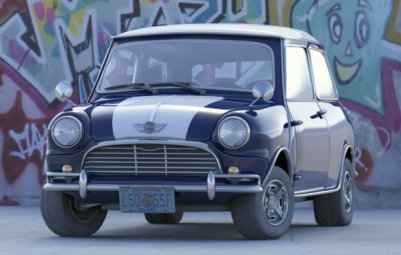
Rendering done by Richie using Yafray. See this gallery for more.
Blender is ideal as the primary modeller for all projects. Blender has a strong community of users and open source developers, and so it develops rapidly. In our experience it has a much wider support and HOWTO base than existing proprietary modellers due to the enthusiasm of the large community using it. Natively it has excellent free documentation and a paper manual if purchased. Runs on Linux, Wintel, FreeBSD, OSX, Solaris. Download it here.
|

GtkRadiant is an excellent level editor for the following games:
Doom 3
Tenebrae2
Quake 2
Quake 3
Return To Castle Wolfenstein
Enemy Territory
Jedi Knight II: Jedi Outcast
Jedi Knight III: Jedi Academy
Medal of Honor: Allied Assault
Call of Duty
Heretic 2
Soldier of Fortune II
Star Trek: Elite Force
The community for GtkRadiant is very active as it is the most popular editor for many of these games. It has a plan-view interface with a good 3D windowand texture browser. Scene textures and all entities being used in the game (and their relationships to other objects/entities) are visible in the 3D view.
GtkRadiant includes CSG editing, flexible 'brush based' editing, shader editing, support for models in the md2 format and creation of basic curves and primitives.
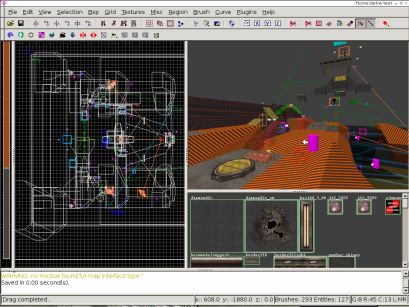
Projects are compiled to BSP format for the given game and have verbose output for debugging, finding 'leaks' etc. The game can be started up at the point of a map compiling which is often very convenient. Runs on Linux, OSX and Wintel.
|

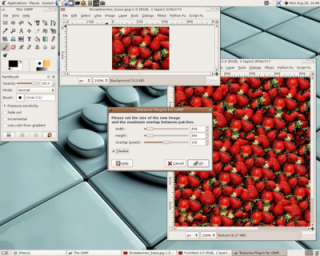
The Gimp Texturizer makes a welcome addition to the free-software game developer's inventory. This excellent little Gimp plugin will take any image and make it seamlessly tileable. I tried with several complex textures, it was so easy it was almost boring, and the results were great.
Gimp is already a highly capable Photoshop replacement for the texture editor, but one area lacking has been in the area of 3D painting. The folk from the Verse project provide an interface between Gimp and Blender for exactly this purpose; ala Deep 3d, this equates to the full extents of The Gimp available to you in Blender while texture painting right onto the mesh.
Thx to the lovely Petite for pointing me to the plugin (damn alliteration)..
|

Word on the street is (after aeons of anticipation) that iD is soon to release the Quake3 sourcecode. Apparently Carmack announced this at QuakeCon moments ago.
This is big news for game developers and artists looking to develop unique standalone projects in a BSP friendly engine with a solid networking layer. Let's hope the license the src is released under is GPL, or GPL friendly.
Quake3 has a fairly robust toolchain and is a well proven engine. I don't need to tell you that though do I!
|

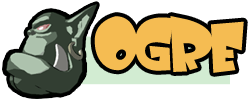
.. and what a changelog it is, albeit largely a bugsquashing / maintenance release.
For those of you not in the know, Ogre3D is a commercial grade open-source 3D engine designed for use in games. It has a very capable Python API, GLSL shader support, bezier and LOD meshes. Ogre3D has an asset pipeline that supports a variety of packages from Blender to 3DSMax. It sports a sensible object oriented interface independent of 3D implementation. It's true, I copied that last sentence from the feature page.
For those that don't know, or care, what all of that means, click here.
|
|
tech: Blender Workshop at COPYFIGHT, Barcelona.
|
|

I'll be giving a short workshop on game development using Blender here at COPYFIGHT, Barcelona on Saturday 16 at 11am.
If you're in the area, come along with your laptop and a wheel mouse. It's completely free but we will be getting started at 11am on the dot.
Despite the fact C3PO appears on the workshop page, there will not be a Star Wars theme to the workshop; where that image comes from I have no idea..
Anyone that has actually seen Revenge of the Shit Sith will surely be glad to hear this.
|

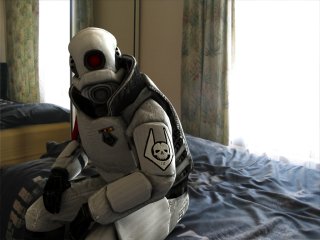
Cheers Ulrik!
|
|  |
| Sunday, May 22 | | · | Solipsis - P2P Virtual World |
| Monday, March 21 | | · | Powerbook as Human Input Device. |
| Thursday, March 10 | | · | Mutable Interfaces |
| Tuesday, March 08 | | · | More Hardware Hacking. |
| Thursday, February 24 | | · | Fluxus, 0.6b1 release |
| Tuesday, February 15 | | · | Koders |
| Sunday, February 13 | | · | The Future of Video Games (apparently).. |
| Thursday, November 25 | | · | GameCube grows up, leaves home |
| Monday, October 18 | | · | Make Human |
| Thursday, September 09 | | · | cat /unix > /dev/gameboy |
| Tuesday, August 31 | | · | 2 New Tools |
| Sunday, August 22 | | · | XGameStation |
| Thursday, August 19 | | · | Console Us |
| Monday, August 09 | | · | Talk-fest in Team Fortress |
|
|
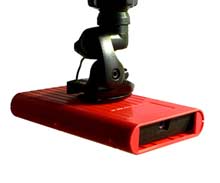



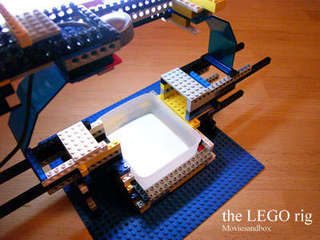
 While here at
While here at 
